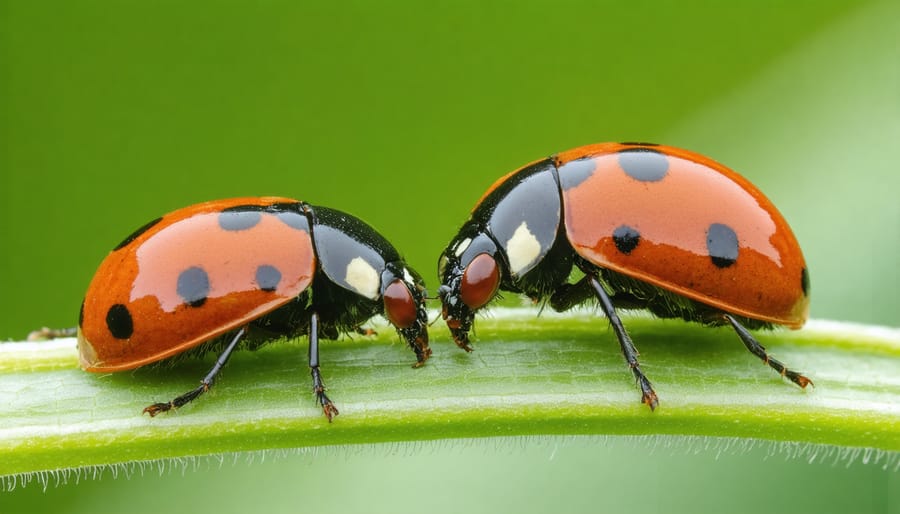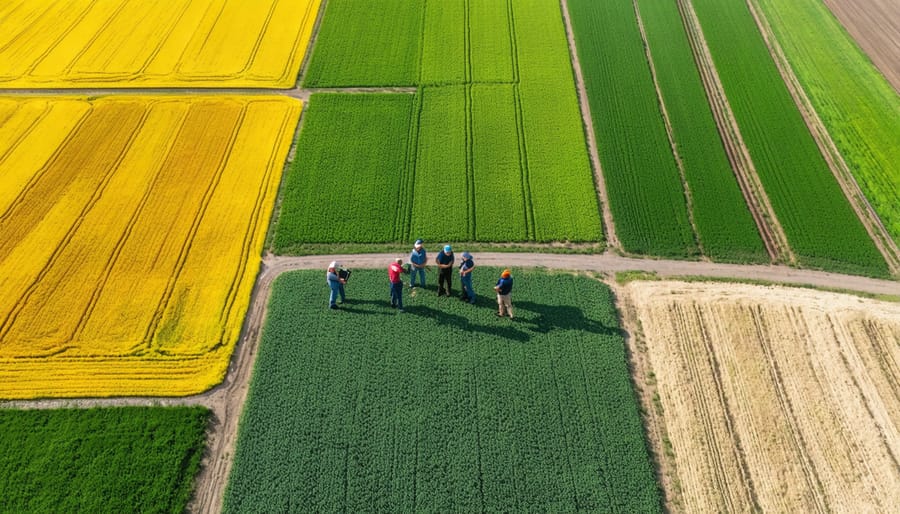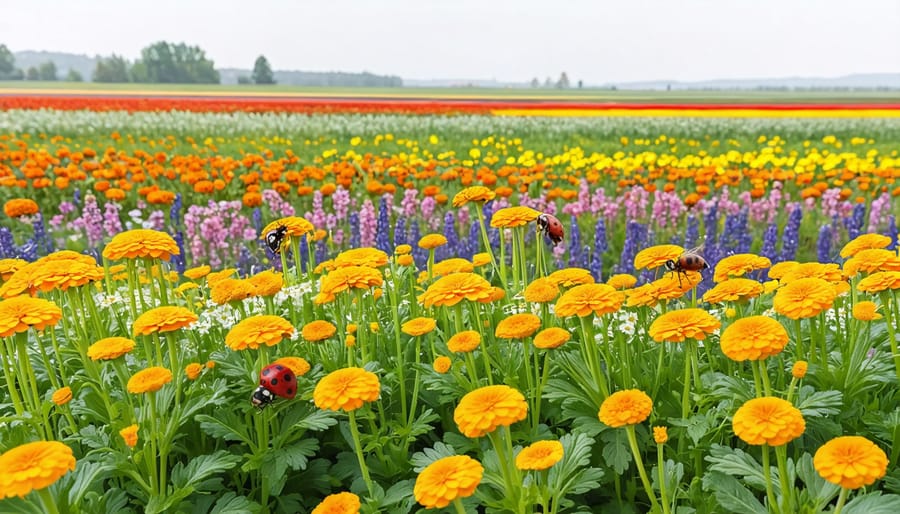Modern pest control in Canadian agriculture demands a strategic blend of biological, chemical, and cultural methods that protect both crops and the environment. Every year, agricultural pests cause an estimated $4 billion in crop losses across Canadian farms, making effective pest management crucial for sustainable food production and farm profitability.
Successful pest control begins with understanding your local ecosystem and implementing integrated pest management (IPM) strategies that work with nature, not against it. From the canola fields of Alberta to the wheat belts of Saskatchewan, farmers are discovering that combining traditional methods with innovative technologies yields better results than relying on any single approach.
Today’s agricultural pest control focuses on prevention, monitoring, and targeted intervention. By employing routine field scouting, beneficial insect conservation, and precision application technologies, Canadian farmers are reducing pesticide use while maintaining or improving crop yields. This approach not only protects the immediate harvest but also builds long-term soil health and ecosystem resilience.
The future of agricultural pest management lies in this balanced, ecosystem-based approach that considers both immediate crop protection needs and long-term environmental sustainability. As climate patterns shift and pest pressures evolve, adapting these strategies becomes increasingly vital for Canadian agriculture’s continued success.
Understanding Your Farm’s Natural Defense System
The Alberta Advantage: Local Beneficial Species
Alberta’s unique ecosystem harbors a diverse array of natural predators that serve as valuable allies in pest management. Our province’s beneficial insects include the native ladybird beetles, particularly the thirteen-spotted lady beetle, which effectively controls aphid populations in canola and wheat fields. Ground beetles, abundant in our prairie soils, help manage slugs, caterpillars, and other ground-dwelling pests.
Parasitic wasps, such as the native Braconid species, are particularly effective against cabbage loopers and armyworms common in Alberta vegetable crops. Our cold winters actually benefit these beneficial species by providing necessary dormancy periods while helping control pest populations.
Another regional advantage is the presence of native pollinator species like the Alberta mining bee and various bumblebee species, which not only assist in crop pollination but also help maintain habitat diversity that supports other beneficial organisms. These indigenous species are well-adapted to our local climate and farming practices, making them reliable partners in sustainable pest management strategies.

Your Soil’s Secret Weapon Against Pests
Healthy soil is your farm’s first line of defense against destructive pests. Here in Alberta, farmers who invest in soil health consistently report fewer pest problems and stronger crops. The secret lies in the complex network of beneficial microorganisms that thrive in well-maintained soil.
These microscopic allies work tirelessly to create natural pest resistance. When your soil is rich in organic matter and maintains proper pH levels (ideally between 6.0 and 7.5), it supports beneficial nematodes and predatory microbes that naturally control pest populations. Additionally, healthy soil helps plants develop stronger root systems and natural defense mechanisms against pests.
Local farmer Jim Thompson from Red Deer County saw a 40% reduction in root maggot damage after implementing a three-year soil improvement program focusing on crop rotation and reduced tillage. “The difference in plant resilience was remarkable,” he notes. “We’re seeing stronger plants that naturally resist pest pressure.”
To boost your soil’s pest-fighting capabilities, consider incorporating cover crops, maintaining proper drainage, and regularly testing soil composition. Remember, healthy soil doesn’t just fight pests – it’s the foundation of sustainable farming.
Building a Pest-Resistant Farm Ecosystem
Crop Diversity and Rotation Techniques
Diversifying your crop selection and implementing strategic rotation patterns are powerful tools in your pest management arsenal. Here in Alberta, we’ve seen remarkable success with three to four-year rotation cycles that effectively break pest life cycles and reduce population buildups.
Consider the experience of Derek Thompson, a third-generation farmer near Lethbridge, who reduced his pesticide use by 40% after implementing a diverse rotation including canola, wheat, and pulse crops. “The key is thinking beyond just the next season,” Thompson explains. “Each crop brings different benefits to the table.”
To maximize the benefits of crop diversity, consider these proven strategies:
– Alternate between crops from different families (e.g., cereals, legumes, brassicas)
– Include cover crops during shoulder seasons
– Plan for natural pest-suppressive crops like mustard or buckwheat
– Leave appropriate intervals between similar crops (minimum 2-3 years)
Research from Agriculture Canada shows that fields with diverse rotations experience up to 60% fewer pest problems compared to those with limited rotation. The practice also promotes beneficial insect populations that naturally control pest species.
Remember to maintain detailed records of your rotation patterns and pest observations. This information becomes invaluable for future planning and helps identify which combinations work best for your specific situation. Consider collaborating with neighbouring farms to create larger areas of diverse cropping patterns, which can enhance the overall effectiveness of pest management in your region.

Habitat Management for Natural Predators
Creating welcoming environments for beneficial insects and natural predators is a vital component of sustainable pest management in Alberta’s agricultural landscape. By establishing diverse plant communities around field edges and within buffer zones, farmers can attract and sustain populations of helpful insects that naturally control pest species.
Consider incorporating flowering plants like yarrow, dill, and native asters along field margins. These plants provide nectar and pollen resources for beneficial insects throughout the growing season. Many Alberta farmers have found success with beetle banks – raised strips of native grasses that offer winter shelter for ground beetles and other predatory insects.
Maintaining permanent hedgerows and windbreaks serves multiple purposes: they protect beneficial insect populations, reduce wind erosion, and create corridors for natural pest predators to move between fields. Local species like wolfwillow and chokecherry are excellent choices that adapt well to our climate while supporting diverse insect communities.
Reducing tillage in field margins and leaving some crop residue over winter provides crucial overwintering habitat for beneficial insects. Several farmers in central Alberta have reported increased populations of ladybugs and parasitic wasps after implementing these practices.
Remember to maintain these habitat areas with minimal pesticide use. Consider establishing buffer zones of at least 3 metres between sprayed areas and beneficial insect habitats. This approach has shown promising results in supporting both crop protection and biodiversity on Canadian farms.
Cover Crops as Pest Management Tools
Cover crops are proving to be one of our most effective natural pest management tools here in Alberta. These strategic plantings work as nature’s own pest control system, creating barriers and habitat modifications that naturally suppress harmful pest populations.
Many Alberta farmers have found success using fall rye and mustard varieties as cover crops, which release natural compounds that deter soil-borne pests. For instance, the Thompson family farm near Red Deer reduced their wireworm populations by 60% after implementing a fall rye cover crop system over two seasons.
Beyond pest suppression, cover crops provide multiple benefits for your soil health. They prevent erosion, improve organic matter content, and support beneficial insects that prey on crop pests. Clover and vetch are particularly effective at attracting predatory wasps and beetles that feed on harmful insects.
To get started with cover crops for pest management, consider these practical steps:
– Plant cover crops immediately after harvest to maximize growth
– Choose species that winter-kill in our climate to ease spring management
– Consider mixing multiple species to target different pest problems
– Monitor pest populations before and after implementation to track success
Remember that timing is crucial in our short growing season. Many farmers find success by frost-seeding red clover into wheat in early spring, allowing the cover crop to establish without competing with the main crop.
Real Success Stories from Alberta Farms
Southern Alberta Grain Farm’s Transformation
In 2018, the Morrison family farm near Lethbridge transformed their 1,200-hectare grain operation from conventional pest control to an integrated pest management system, yielding remarkable results within just three growing seasons. Jim Morrison, a third-generation farmer, initially faced skepticism from neighboring farms when implementing diverse crop rotations and beneficial insect corridors.
The farm established 3-meter-wide flowering strips between wheat and canola fields, creating habitat for predatory insects like lady beetles and parasitic wasps. They also introduced trap crops around field perimeters, effectively drawing pests away from main crops. This strategy reduced pesticide use by 65% while maintaining yield targets.
Collaboration with local agronomists and Agriculture Canada researchers helped monitor pest populations and timing of interventions. The farm developed a custom smartphone app for field scouts to track pest presence and beneficial insect activities, enabling data-driven decisions about when intervention was necessary.
Financial results exceeded expectations, with pest management costs decreasing by $45 per hectare annually. The farm’s soil health improved significantly, and beneficial insect populations increased threefold by 2021. The Morrison family now hosts regular field days, sharing their experience with other Alberta farmers interested in sustainable pest management.
Their success has inspired twelve neighboring farms to adopt similar practices, creating a growing network of integrated pest management practitioners in Southern Alberta.

Central Alberta Market Garden’s Strategy
Located just outside of Red Deer, the Central Alberta Market Garden has become a shining example of integrated pest management success. Owner Sarah McKenzie transformed her 15-hectare operation from conventional pest control methods to a holistic approach that has reduced pest-related crop losses by 65% over three years.
McKenzie’s strategy combines companion planting, beneficial insect corridors, and targeted biological controls. “We started by mapping our most vulnerable areas and identifying our primary pest challenges,” she explains. “Then we designed our garden layout to maximize natural pest control relationships.”
The garden now features strategically placed flowering borders that attract ladybugs, lacewings, and parasitic wasps. These beneficial insects help control aphids and caterpillars that previously damaged their high-value crops like tomatoes and leafy greens. They’ve also introduced trap crops around the perimeter, drawing potential pests away from main production areas.
What sets this operation apart is its community-based monitoring system. Local master gardeners volunteer weekly to help track pest populations and beneficial insect activity. This data helps inform timing for interventions and has created a valuable educational resource for other market gardeners in the region.
The garden’s success has inspired neighbouring farms to adopt similar practices, creating a growing network of sustainable pest management in Central Alberta. Annual workshops now share these methods with other producers, fostering a collaborative approach to regional pest control.
Measuring and Monitoring Success
Simple Field Assessment Tools
Regular field assessment is crucial for effective pest management, and Alberta farmers have access to several straightforward tools that make monitoring pest populations more manageable. A sweep net remains one of the most reliable tools, allowing you to collect and identify insects across your fields with just a few passes. Yellow sticky traps, placed strategically throughout your crops, provide ongoing insect monitoring and early warning of potential infestations.
For soil-dwelling pests, the trusty spade method involves digging small sample holes and examining the soil carefully. Many Alberta farmers keep a magnifying glass handy for quick field identification of smaller pests and beneficial insects. Daily crop walking with a simple notebook for recording observations helps track patterns and changes over time.
Temperature and moisture meters are valuable additions to your toolkit, as pest activity often correlates with specific environmental conditions. Consider using your smartphone to photograph and document pest damage – many extension offices now offer apps that can help with pest identification from these images. These basic tools, when used regularly, provide the foundation for informed pest management decisions.
When to Adjust Your Approach
Regular monitoring and assessment are key to successful pest management. Consider adjusting your approach when you notice changes in pest populations, crop damage patterns, or environmental conditions. Here in Alberta, we’ve seen how quickly things can shift – from unexpected frost periods affecting insect lifecycles to drought conditions bringing new pest challenges.
Watch for signs that your current strategy isn’t working as effectively as before. This might include increased crop damage despite treatment, unusual pest behaviour, or the appearance of secondary pest problems. Early spring soil temperatures and moisture levels can be particularly telling indicators of when you might need to adapt your approach.
Pay attention to your neighbours’ experiences too. Our farming community has valuable insights to share, and what’s happening in nearby fields often forecasts what you might face soon. Consider adjusting your strategy if you notice resistance developing to certain control methods – this is particularly important with chemical controls.
Weather patterns, especially extreme events, should trigger a review of your pest management plan. For example, after a mild winter, you might need to start monitoring earlier and adjust your control timeline accordingly.
Remember, successful pest management is about being proactive rather than reactive. Regular consultation with local agricultural extension officers can help you stay ahead of emerging pest challenges.
As we’ve explored throughout this guide, effective pest control in agriculture requires a balanced, thoughtful approach that considers both immediate results and long-term sustainability. The success stories from farms across Alberta demonstrate that integrating multiple control methods – from biological controls to precision monitoring – yields the best outcomes for both crop protection and environmental stewardship.
Remember that implementing comprehensive pest management doesn’t happen overnight. Start with small, manageable changes and gradually expand your approach. Whether it’s introducing beneficial insects, adjusting crop rotation patterns, or adopting new monitoring technologies, each step forward contributes to more resilient farming operations.
The growing network of Canadian farmers embracing innovative pest control methods shows we’re stronger when we work together. Consider joining local agricultural associations or participating in farmer-to-farmer mentorship programs to share experiences and learn from others’ successes and challenges.
As climate patterns continue to shift and pest pressures evolve, staying informed and adaptable will be crucial. Take advantage of resources available through provincial agricultural extensions and research institutions. Most importantly, document your pest control efforts and outcomes – this information becomes invaluable for future planning and helps contribute to our collective understanding of effective pest management in Canadian agriculture.
By implementing these strategies thoughtfully and sharing our experiences, we can build more resilient agricultural systems that support both productive farms and healthy ecosystems for generations to come.








